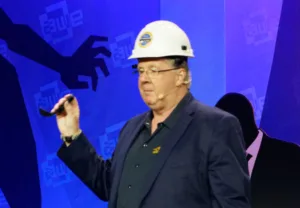We managed to make the most of our stay on the West Coast of the USA for SID and Infocomm to make a visit to Augmented World Expo, the undoubted major event in the AR world, as it takes place in Santa Clara in Silicon Valley and has attendees from all the major vendors and interested parties especially developers. The event has a conference and an expo, but the organisers are keen to promote conference rather than just the Expo, so it is only on for two days and on one of those (the day we visited), the show floor is only open from 11.00 am to 5:00pm and we very nearly got to everybody that we wanted to. There were just a couple we didn’t make it to, but it was a busy few hours!
A highlight for me was the demo by Varjo of its latest mixed reality system. The headset has very good central resolution and combines this with a wide field of view to create a very impressive mixed reality sense. (Varjo Mixed Reality Demo is Impressive)
The event started with an overall press conference, where many exhibitors were given just a few minutes to talk about what they were showing.
AWE Press Event
Kopin talked about its solutions including the Golden-i Infinity which can delver up to 2600 cd/m² (see Kopin Golden-I is Light)
Kopin showed its new Golden-i Infinity viewer. Image:Meko
Andy Lowry is CEO of Realwear and he said that industrial sites such as gas and oil production sites do not allow any consumer electronics devices because of the danger of stray sparks or other potential hazards.
Realwear has an Atex-certified (into a range of different zones) AR headset, the HMT-1, and now there is a new product HMT1= Z1 which has been shipping in pilot numbers for testing, but is now in volume production. The latest version can be used ‘completely hands free’ Lowry said and Honeywell is the first volume client for production.
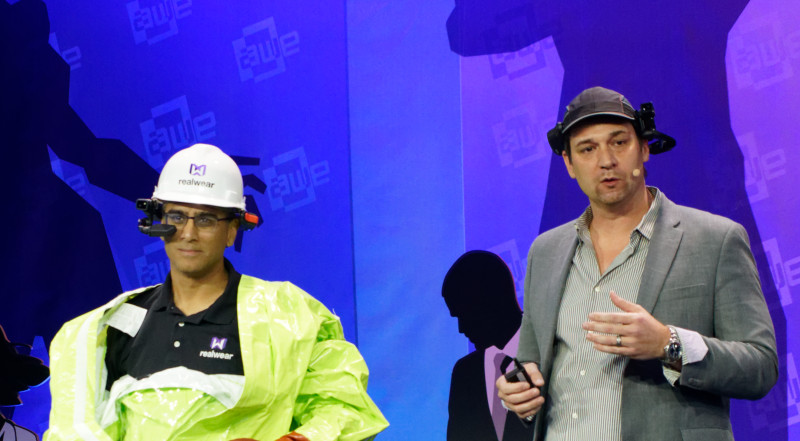 Realwear is developing Atex-certified AR devices for hazardous environments. Image:Meko
Realwear is developing Atex-certified AR devices for hazardous environments. Image:Meko
Spex is from eSight which has developed products for a long time and is now working in AR/VR. The headset is designed to be tilted from a VR type immersion mode to a raised mode when it is completely out of the way of the users vision. The headset uses a high acuity camera with 24X zoom. Objects can be seen as solid, rather than fading when the headset is down, the company said, as the headset uses occluded OLED displays. The company claims that the acuity of the camera/display combination has higher visual acuity than the naked eye and the headset includes two way voice and video. The headset uses Android as a platform. (Spex Concentrates on Improving Vision)
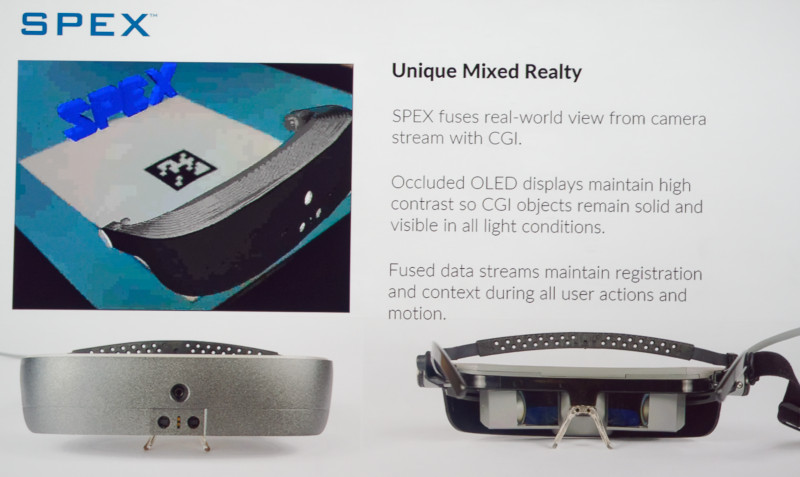 Applications for the Spex include medical and military, industrial and manufacturing. Image:Meko
Applications for the Spex include medical and military, industrial and manufacturing. Image:Meko
Wikitude said that AR used to be very local and personal, one-dimensional and also temporary. Then Pokemon Go came out and brought AR to the outdoors and made it global and social, as well as persistent. The Pokemon Go is not the latest and greatest technology, but was good to show the possibilities of persistent AR.
There is a new SDK 8.0 from the company which allows persistent instant target creation and storage in an AR-cloud – to allow the viewer to “come back later”. The SDK now includes object and scene recognition. Wikitude now has a free access programme for students, hobbyists, start ups to help to develop new concepts and applications.
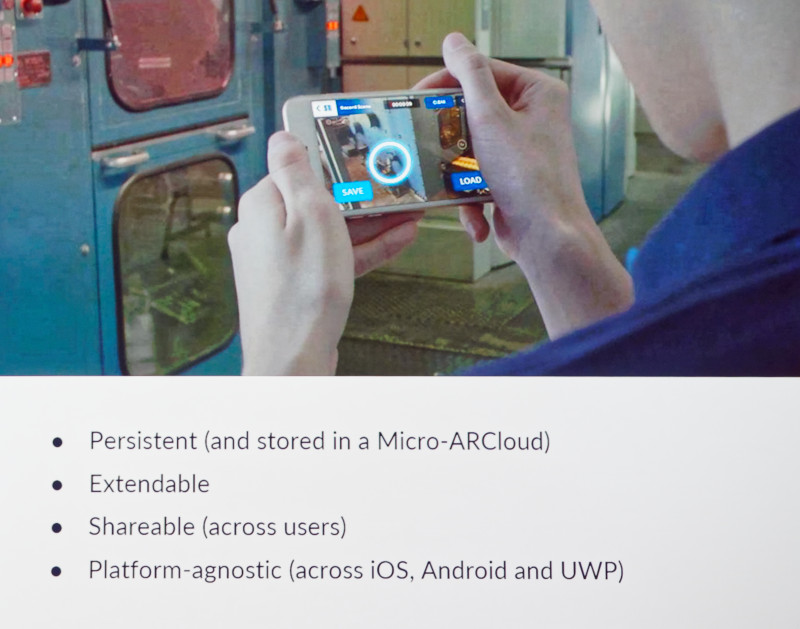 Wikitude has made its SDK available free for non-professional users. Image:Meko
Wikitude has made its SDK available free for non-professional users. Image:Meko
Vyking makes apps and tools for augmented reality. The company has an SDK with 3D graphics animation and which has an advertising server connected, so it can serve AR ads. Foot tracking is a new function and can allow footwear ‘try-on’ simulation for virtual shopping. The company is focusing on AR for eCommerce with facial recognition for applications such as make-up and cosmetic sales applications. The company claims a high level of accuracy and detail with 3,000 unique parameters being tracked.
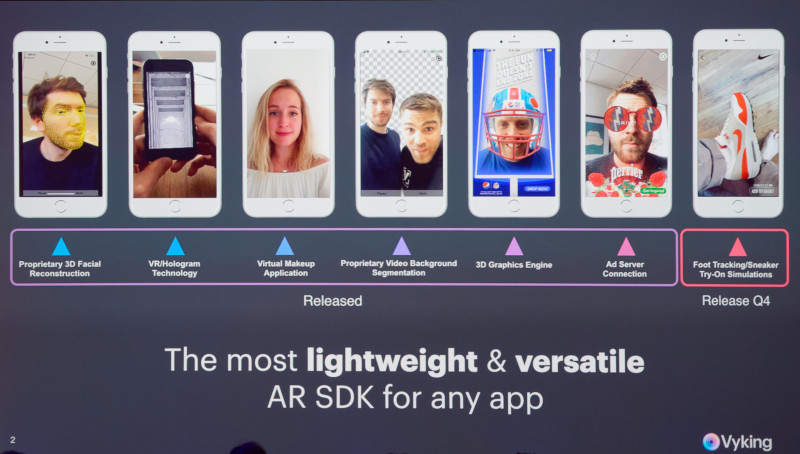 Vyking is concentrating on AR for commercial applications. Image:Meko
Vyking is concentrating on AR for commercial applications. Image:Meko
Qualcomm is working with Vuzix on its XR1 AR/VR platform for mainstream audiences. Vuzix will have products next year using the XR1 platform in enterprise and also commercial applications in 2019 or 2020. Vuzix also said that it is working with Plessey’s Quanta-Brite microLED light sources which are expected to allow optical systems to be up to 50% smaller as well as lighter and cheaper than current technology.
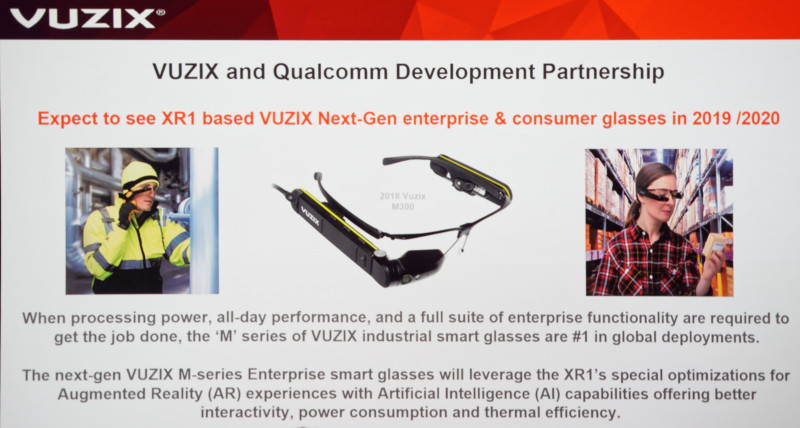 Vuzix and Qualcomm are working together to develop the next generation of AR headsets. Image:Meko
Vuzix and Qualcomm are working together to develop the next generation of AR headsets. Image:Meko
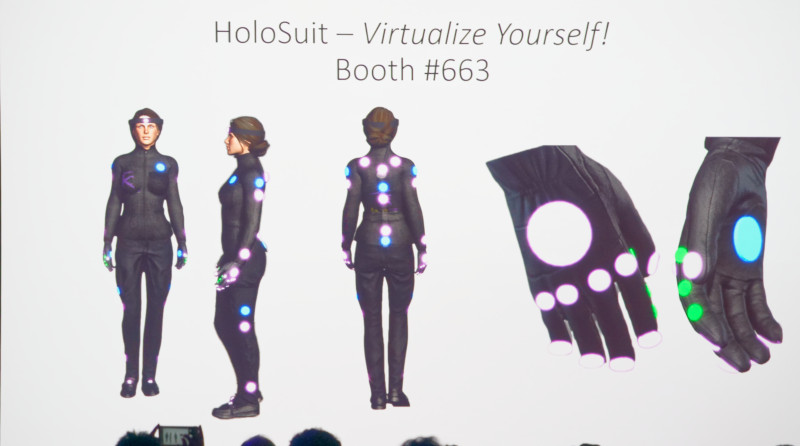 Holosuit said that its body suit with haptic feedback is being used by sports (cricket) and by industrial users for training. Image:Meko
Holosuit said that its body suit with haptic feedback is being used by sports (cricket) and by industrial users for training. Image:Meko
Ultrahaptics explained how it is using ultrasound to feel touch and texture without physical contact.
NuHeara is developing “augmented hearing” which it described as “AR for your ears” and the company said that it can blend the real and virtual audio worlds. The aim is to “enrich the user’s lifestyle” and the technology can be used for improving hearing.
Zapbox has a new cardboard AR solution with a $30 cost. Today it has the new Zapbox 2 which is much smaller to store and ship. The set consists of an MR headset based on smartphone, with lenses and dual controllers. Later the company will develop a collaborative experiences API via the cloud. The controllers can be tracked in real time, Zapbox said.
Urjo Konttori is the CEO of Varjo and he talked about the Varjo headset which was being demonstrated in a hotel suite. Check our main report for our impressions of the latest version. (Varjo Mixed Reality Demo is Impressive)
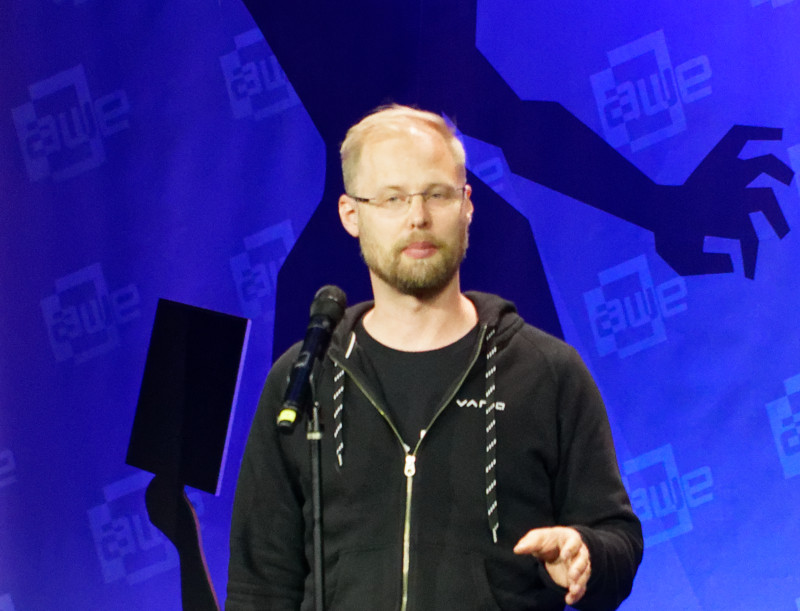 Urjo Konttori is the CEO of headset maker, Varjo. Image:Meko
Urjo Konttori is the CEO of headset maker, Varjo. Image:Meko
Mantis Vision has technology that is being used by Xiaomi. The company has algorithms to create stuctured light with very tight code for facial recognition and AR which it can support in real time in Android using face cameras.

